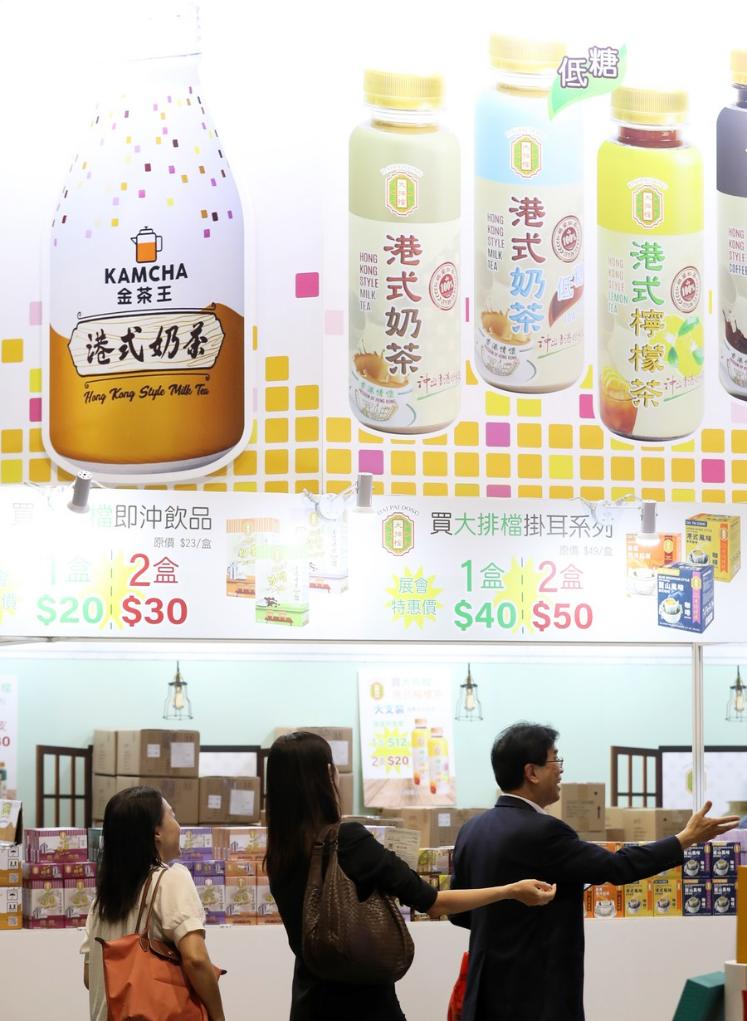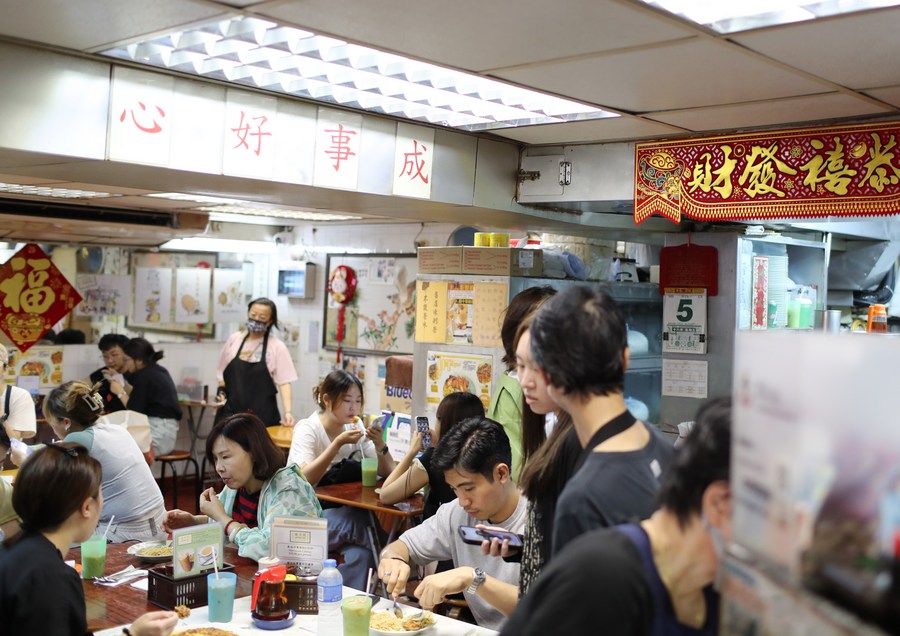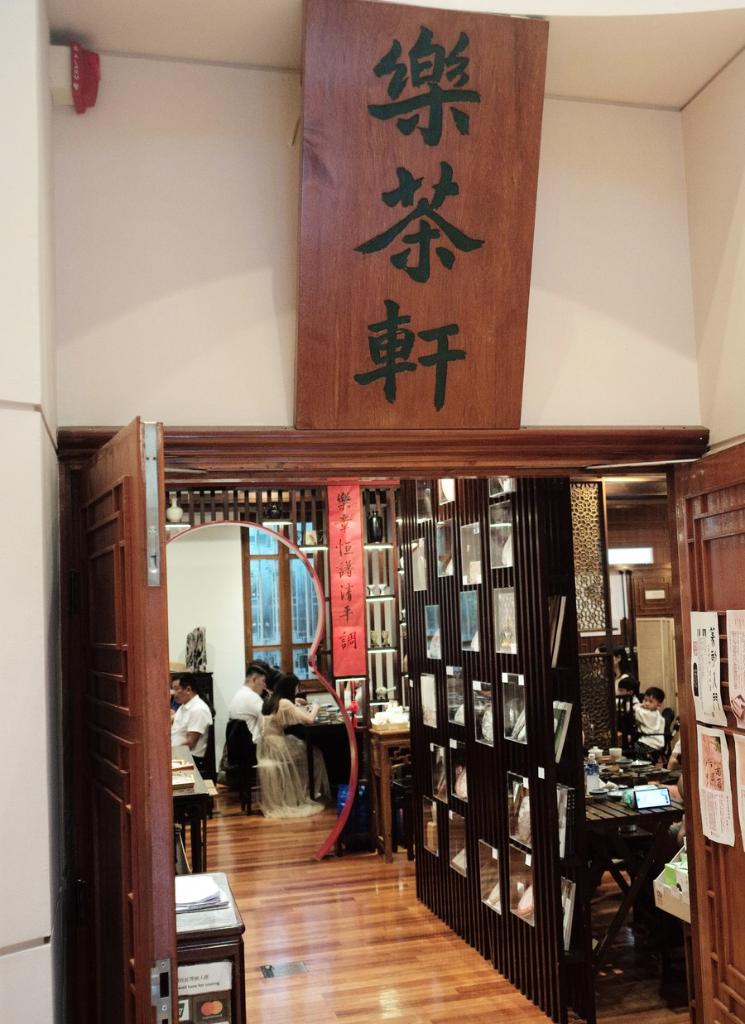Way too easy to find congenial teas to drink in Hong Kong

A poster seen at a Hong Kong-style milk tea booth at Hong Kong International Tea Fair, Aug. 17, 2023. (Xinhua/Li Gang)
An international city of multiculturalism boasting various ethnic communities, Hong Kong offers multiple tea beverages characterized by different backgrounds for people to enjoy and communicate with each other.
by Xinhua writers Qu Junya, Annie Cheung, Wang Qian
HONG KONG, Sept. 25 (Xinhua) -- It would not be difficult for a stranger to find his congenial teas to drink in Hong Kong as the metropolis enjoying cultural diversity with the contribution from its various ethnic communities offers a long list of tea drinks.
Among them Hong Kong-style milk tea is nonetheless the most locally distinctive and deserves a try, maybe above everything else. As official data show, Hong Kong's more than 7 million residents consume 2.5 million cups of milk tea per day.
VINTAGE MILK TEA
Notably, Lan Fong Yuen is known for its vintage Hong Kong-style milk tea, served with popular options of French toast or pork chop buns on the food menu. The Central-based tea dining room or Cha Chaan Teng in Cantonese debuted an eight-step tea brewing technique in 1952 and has remained committed to the technique, as well as to manual labor fully in its tea making.

This photo shows Lan Fong Yuen main restaurant located on Gage Street in Central, Hong Kong, July 5, 2023. (Xinhua/Li Gang)
Today its old Dai Pai Dong sidewalk snack booth on Gage Street stands still there, with a queue often seen outside, sometimes with tourists or local personalities arriving to get or recall the old taste of Hong Kong.
Hong Kong-style milk tea is known for being a rich, creamy and aromatic blend of the black tea and evaporated milk. Lan Fong Yuen's current version combines several black teas mainly from Sri Lanka and the non-dairy creamer -- a recipe unchanged for more than 20 years.
"Recipe had been upgraded after many trials of different ingredients and their varying proportions, and I'd invited people to drink and give opinion," said Lam Chun-chung, the second-generation restaurant owner who developed the current recipe.
"Non-dairy creamer was chosen simply for the flavor." Adding sugar has ever been an option by customers, he added.
The making of Hong Kong-style milk tea features the use of a filter bag in pouring tea several times to bring out the tea's aroma. The white cloth bag would get colored to turn brown over time, hence the milk tea's nickname "silk stocking".
In 2017 Hong Kong-style milk tea making technique was put in the first intangible cultural heritage inventory of Hong Kong, indicating time-tested flavor and popularity of the iconic beverage amid a treasure of locals' tea drinking habits. Hongkong Post in July 2023 issued special stamps on this theme.
The milk tea is officially described as "the outcome of a century-old evolution from English milk tea. The tea-making technique does not only epitomize the fusion and development of Hong Kong's East-meets-West food culture, but also gives a glimpse of how locals live and eat."
Lan Fong Yuen's milk tea business, moreover, reflects the economic success story of Hong Kong, which started from scratch in the 1950s with the policy introduced to encourage Dai Pai Dong sidewalk snack booth business to provide both jobs and cheap meals in the benefit of the grassroots' livelihood.

People dine at Lan Fong Yuen main restaurant located on Gage Street in Central, Hong Kong, July 5, 2023. (Xinhua/Li Gang)
Lam, 68, nearly the age of the tea restaurant, said the customers, mostly, were initially neighbors, gradually blue collar workers coming over during the afternoon tea time, and later with the development of Central, included a lot of white collars from office buildings.
In recent years tourists were seen in the restaurant, mainly from Southeast Asia, and also from the Chinese mainland, he added.
Deeming it a significant factor of both local culture and a prosperous catering industry, Association of Coffee and Tea of Hong Kong (ACTHK) in 2009 launched the annual international KamCha contest to promote Hong Kong-style milk tea, with this year's Hong Kong section finals held at Hong Kong International Tea Fair in August.
Featuring milk tea, Hong Kong's afternoon tea break at around 3:15 p.m. is also traced back to English afternoon tea, said ACTHK chairman Wong Ka Wo, whose father started a local business in the trade of black tea and coffee in the 1930s.
VARIED TEA DRINKS
Hong Kong's small street tea booths can afford a great richness of tea drinks, including specimens of milk teas evolved locally and elsewhere, along with pure, bubble and fruit teas, many a testament to modern city's fast-paced lifestyle and diet trends.
The classic English afternoon tea, which gave way to Hong Kong-style milk tea long time before Hong Kong returned to the motherland in July 1997, is now served mostly in big hotels. Some are known for fancy tea cakes, or for uninterrupted formalities, such as live string music playing, strict dress code, conventional English tea time snacks, as well as Southeast Asian light refreshments, reminiscent of Hong Kong being a sea gate to South China.
Some of the Japanese tea houses sitting amid Hong Kong's forest of high rises offer Japan-produced teas solely while Central-based Indian restaurants would freshen you up with the delicious Masala Chai, a compound beverage giving off a mixed aroma of multiple spicy ingredients including cinnamon and cardamon.
Hong Kong is an international city of multiculturalism boasting various ethnic communities, hence multiple tea beverages characterized by different backgrounds for people to enjoy and communicate with each other.
If one wants to taste a tea as tea literally, some Chinese tea shops operating from the 1930s in Sheung Wan are a good choice, which are proud of their old brand fermented tea products combining selected mainland tea leaves and local charcoal firing through conventional methods. Sipping a tea there is concurrently tasting its purity, freshness, and gentle scent.
CHINESE TEA CULTURE
Another wonderful place for sipping tea may be the tea restaurant situated in the K.S. Lo Gallery, which is part of the Flagstaff House Museum of Tea Ware. Tea there can be also served along with food, while the tea set on each table with purple clay teapot or lidded teacup allows patrons to take delight in a leisurely DIY service.

This photo shows the tea restaurant LockCha situated in the K.S. Lo Gallery on July. 8, 2023. (Xinhua/Li Gang)
Moreover, the tea sipping experience can be enriched by a visit to the tea ware museum at the next door building, where the wall display boards and exhibits give a brief account of how ancient Chinese made tea through boiling, whisking or brewing. The museum also holds free tea parties regularly for education on the art of Chinese tea drinking.
It organized a special lecture some time after traditional tea processing techniques and associated social practices in China was in November 2022 added to the intangible cultural heritage list of the United Nations Educational, Scientific, and Cultural Organization (UNESCO), said Assistant Curator I, Lam Suet-hung.
In its latest move, the museum in August launched an exhibition titled "The Art of living: Stationery and Tea Accessories of the Chinese Literati", whereas the Ming and Qing Dynasty antiques on display provide a unique perspective on Chinese tea culture.

Teapots on display in Flagstaff House Museum of Tea Ware on Aug. 8, 2023. (Xinhua/Li Gang)
The vast treasure of Chinese tea culture is beyond words, Lam said, noting that its spiritual essence lies in passing down traditions and communication, with tea as the media, between people, and between human and nature as well.
In her opinion, "It (The tea) integrates with daily life, carries cultural traditions, and is full of the taste of life."
Outside the tea ware museum is the broad space of Hong Kong Park, and a garden plot in the court, where Longjing, Pu-erh and other tea plants from the Chinese mainland can be identified from a lush growth of woods and grass. Standing in the plot is also a stone tablet inscribed with the Chinese characters meaning "positive action by all through seeking common ground while reserving differences", calligraphy by late scholar and master of Chinese culture, Jao Tsung-I.

Jose Yu Sunsay, founder and chief of the Chinese Tea Culture International Exchange Association, speaks during an interview with Xinhua in Hong Kong, Aug. 17, 2023. (Xinhua/Li Gang)
For promoting Chinese tea culture, Chinese Tea Culture International Exchange Association was founded in 2008, which in 2009 co-sponsored the first Hong Kong International Tea Fair. Jose Yu Sunsay, 85, founder and chief of the association, was present at this year's tea fair despite assisted walking. Citing the cultural blending in Hong Kong-style milk tea, he said he hoped Chinese tea culture, as part of the country's soft power, would reach far along the Belt and Road.
